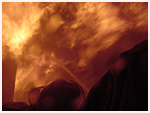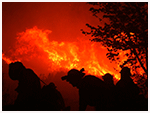« Northern California Brush Fire Deployment | Home | Long Beach Junior Lifeguard Stud Ironman »
Long Beach Fire Station 20 Profiled in the Press Telegram
By frhayes | July 29, 2008
LONG BEACH – For the firefighters of Station 20 in the Port of Long Beach, just showing up for work can be hazardous.
Their station house – a series of “temporary” bungalows erected in 1985 – sits below the crumbling Gerald Desmond Bridge, a monstrous span so decrepit that engineers were forced to place giant nets underneath it to catch chunks of concrete routinely chipping off its underbelly.
Oftentimes the bridge pieces, weighing up to several pounds each, fall harmlessly on Station 20’s roof or driveway, or on Pier D Street nearby.
But they’ve also smashed through the windshield of a firefighter’s parked car and slammed into the station’s detached workshop.
But that’s only a slice of the excitement.
Situated

Within a half-mile are chemical tank farms, oil refineries, metal recyclers, a massive lumber yard, a power plant and several sprawling container terminals.
Supplying these facilities are a few of the world’s largest ships – man-made
behemoths stretching up to 1,200-feet and capable of sailing into just a few of the globe’s biggest seaports.
The hazards posed by these technological marvels are innumerable and real. Imagine, for example, a 120,000-barrel petroleum tanker bursting into flames in the harbor.
The four-member crew from Station 20 would likely be among the first on scene.
“These guys belong to a select group of firefighters anywhere in the world who live on the water and are trained for this kind of responsibility,” said Long Beach Fire Capt. Mike DuRee during a recent visit to the site. “Things like water rescue, dive operations, HazMat, (ocean) vessel fires. Chemical fires can be extremely difficult and dangerous … it’s not an easy job.”
Captain Mike Dollar, the firehouse boss, says his crew feels at home among the tank farms, mega-ships and multi-hued
Fire department engineer Steve Parker discusses the Liberty’s power system in the engine room.
(Scott Smeltzer / Staff Photographer)containers.
“It’s a different atmosphere here on the water and because of that, you approach your work a little differently,” Dollar said. “We all share that bond.”
Part of the challenge firefighters face on boats is limited resources. Although they have backing from Long Beach Lifeguards, Long Beach Fire Station 15 (also in the port) and the neighboring city of Los Angeles Fire Department, resources are scarce, DuRee said.
“You really don’t have that ability on the water to call in unlimited (backup),” Dollar said. “From the water side of it, you have to rely on your (fellow) firefighters) and all the other agencies down here to get things done.”
While they have a full-size fire engine, the jewel of Station 20’s operation is Liberty, an 88-foot, red-and-white fireboat capable of pumping 10,000 gallons of water a minute through its four deck pumps.
The Liberty, which the crew maintains on their own with routine checkups and daily tests, is a firefighting monster in its own right.
Powered by three massive engines, the boat hosts a sonar probe, hazardous materials decontamination station, sleeping quarters and a foam pump used to put down fires on the water.
Firefighter Fred Knaub, the boat driver, says the vessel has been used fighting blazes from Malibu to southern Orange County.
“It’s like a self-contained fire (station),” Knaub said. “We could live on here for a week straight. In fact, some of the guys almost did fighting the Catalina Island fire (in 2007).”
While most days are spent responding to medical emergencies, working on the boat or fighting small flash fires, the crew gets called to assist Homeland Security in fighting terrorism and drug trafficking.
Oftentimes, responders are assisted by Long Beach Lifeguard divers Don Johnson and Cameron Abel, who help when searching for bodies, explosives or illegal contraband stashed under piers or water vessels.
The lifeguards, who drive a smaller, faster boat, are also often used to scout incidents and report back to the larger fireboat.
“They’re our ‘bird dogs,’ and we couldn’t perform our job without them,” DuRee said. “In many ways, they’re the eyes and ears of the fire stations in the harbor.”
In the near future, Station 20’s inhabitants may find themselves with a new home – courtesy of the city’s Harbor Department, which is considering upgrading or replacing the existing structure on Pier D Street.
Port of Long Beach spokesman Art Wong says that if the project is given the green light in coming months, construction could begin sometime in 2010.
The firehouse’s current tenants, however, aren’t complaining about their living space.
“We all feel pretty fortunate to be here,” said Firefighter Rudy Gonzales. “This is kind of a special honor to be down in the port. It takes a certain kind of firefighter to be comfortable on the water doing this.”
kristopher.hanson@presstelegram.com, 562-499-1466
Deprecated: Function link_pages is deprecated since version 2.1.0! Use wp_link_pages() instead. in /home/firechan/public_html/blog/wp-includes/functions.php on line 6121
Topics: News | 36 Comments »



